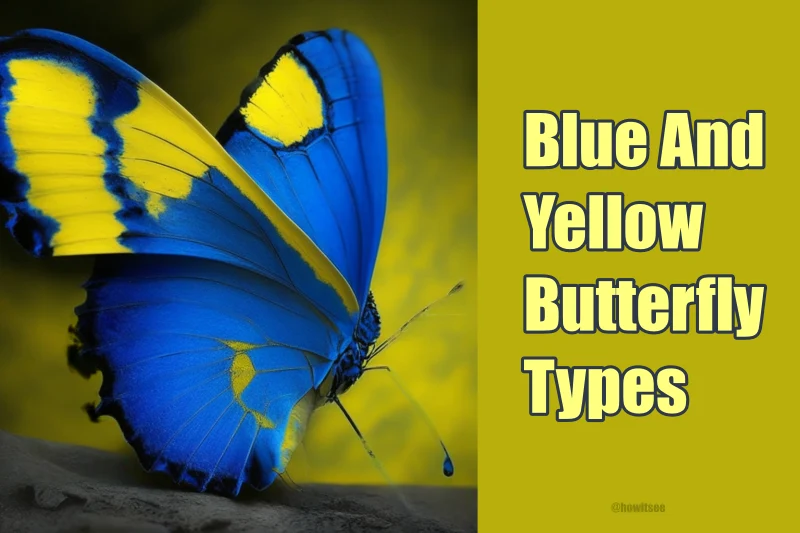Butterflies are considered one of the most beautiful creature found in nature. They look so mesmerizing when seen in different and unique colors. Thus, in this article, we are going to talk about types of butterflies having a contrast of yellow and blue color which makes it worth watching.
Spiritual Meaning of Yellow And Blue Butterflies
The yellow butterflies signifies mental clarity, hope ,spiritual renewal, transformation, change, and new beginnings. They are seen as a symbol of honour and loyalty.
Blue butterfly signifies change or rebirth and it also shows good fortune is on the horizon. They bring emotional depth and insight. Thus, seeing a blue and yellow butterfly is seen as a symbol of good luck, new beginnings, and positivity.
15 Blue And Yellow Butterfly Types
1) Themis forester
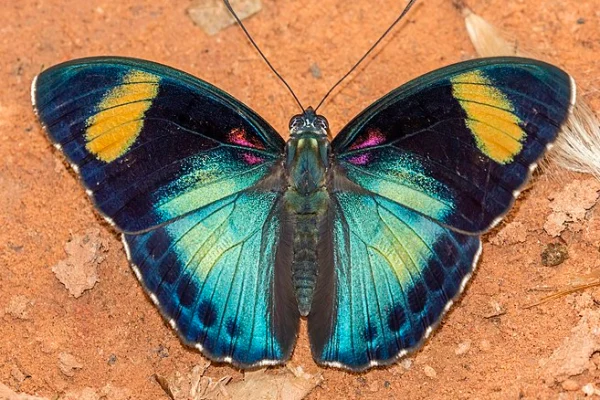
| Scientific Name | Euphaedra themis |
| Size | No Information |
| Location | Nigeria , Ivory coast and Liberia |
| Identification | Blue butterfly with yellow spots |
Euphaedra themis, the common Themis forester, is a beautiful butterfly developed black patterns on the underside, but the submarginal spots on the forewing beneath are in a straight line, and the discal spot in cellule 2 is elongate and stands in the middle of the cellule, or at least reaches the middle.
Also, the wings have a black background and are green, blue, orange-yellow, or white beyond the middle of the hindwing and at the forewing’s hindmargin. Thus, this butterfly adds to the beauty of the nature.
2) Oak leaf
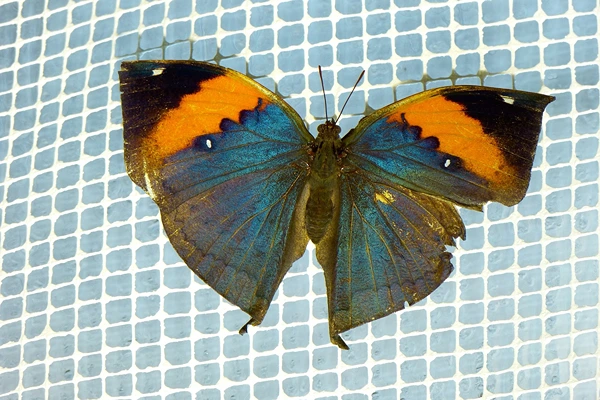
| Scientific Name | Kallima inachus |
| Size | 3.3-4.3 inches |
| Location | India, Nepal and Bnagladesh |
| Identification | It has a leaf like structure with blue and yellow contrast on the wings. |
Kallima inachus, often known as the orange oakleaf, Indian oakleaf, or dead leaf butterfly, is a nymphalid butterfly native to Tropical Asia from India to Japan. With its wings closed, it resembles a dry leaf with dark veins and is a well-known example of camouflage.
The forewing has a black apex, an orange discal band, and a deep blue base when the wings are open. Also, there are two white oculi, one at the apical black band’s boundary and another surrounding the orange and deep blue sections.
The hindwing is more evenly blue, but also with brown patches running along the body.
3) Eastern Tiger Swallowtail Butterfly
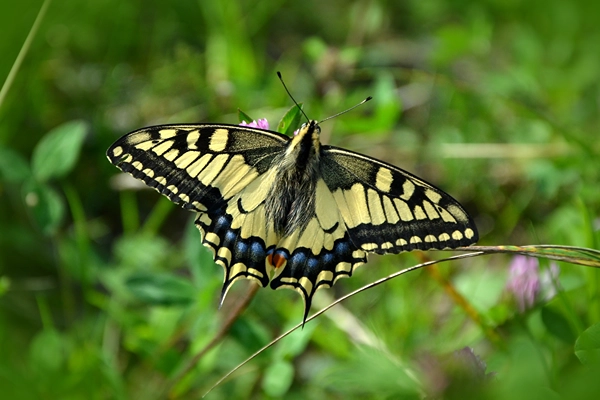
| Scientific Name | Papilio glaucus |
| Size | 3-5.5inches |
| Location | Eastern United States |
| Identification | This butterfly has zigzag wings with yellow and blue contrast. |
The Eastern Tiger Swallowtail butterfly (Papilio glaucus) is one of the most common and beautiful eastern butterflies. Swallowtails are enormous insects. Their hues are quite bright.
The broad yellow wings are bordered in black and have four stripes that run from the forewing borders downward into the yellow wings.
Even, the undersides of the hind wings are very bright, with bluish scales and one or more red dots. Tiger male Swallowtails have darker blacks with no bluish or red scales on their rear wings.
There is an interesting black morph, in which black replaces the broad yellow expanses. The black variants’ hind wings also include bluish and red wing scales.
4) Androgeus Swallowtail
| Scientific Name | Papilio androgeus |
| Size | 135-140mm |
| Location | Mexico and Argentina |
| Identification | This has a black body with blue markings on the wings with yellow dots. |
Males have relatively short and narrow hindwing tails and extended forewings. The fore- and hindwing top feature very broad yellow bands and no marginal rows of yellow dots.
Females are black, with three narrow pointed tails and blue iridescence on the top. Males scout for receptive females in their life history.
Also, Caterpillars resemble bird droppings; eggs are placed individually. This butterfly’s unique contrast makes it a beautiful creature in the nature.
5) Morpho Helena
| Scientific Name | Morpho rhetenor |
| Size | 75-100mm |
| Location | South America |
| Identification | This butterfly has a shiny blue wings with yellow lines. |
Morpho helena, the Helena morpho, is a Neotropical butterfly of the family Nymphalidae. It is found in the rainforests of northern South America. It is known for its metallic blue and shiny wings.
Many authorities consider Morpho helena a subspecies of Morpho rhetenor, and thus is sometimes named Morpho rhetenor helena. Here, the shiny blue wings with a contrast of yellow makes it one of the most beautiful butterflies in the world.
6) Yellow Glassy Tiger
| Scientific Name | Parantica aspasia |
| Size | 60-75mm |
| Location | All through the Asia |
| Identification | This has black body and wings with different patterns of blue and yellow colors. |
The wings’ ground color is mostly bluish grey, with the typical black patterns of the Parantica species. Each wing bears a bright yellow base patch, which covers almost half of the wing surface on the hindwing.
Field Observations of Butterfly Behavior: This butterfly is fairly widespread, and it prefers forested places to open landscape. It flies slowly often floats through the air.
When at rest, it hangs upside down on dried branches, with its wings closed shut. This is mostly found in yellow with blue markings on the body.
7) False Tiger Moth
| Scientific Name | Dysphania militaris |
| Size | 80-96mm |
| Location | China India and Mynnamar |
| Identification | This is a yellow butterfly with blish purple colour on the tips of the wings. |
Male forewings are generated, which are long and narrow. The fovea was well developed. Golden yellowish with purplish marks on the head, thorax, and abdomen.
Forewings have a golden-yellow basal half and a deep violet outer half with an irregularly sinuous inner border. Two oblique basal purple fascia, with a spot detached from the lower fascia on occasion.
Golden yellow hindwings with a huge purple discocellular patch and a spot below the cell. Between veins 3 and 5, a postmedial lunulate band excurved.
Also, at the apex, a submarginal spot series transforms into enormous conjoined lunulate patches. The fragments on the yellow section vary greatly.
8) 4’O’ Clock moth
| Scientific Name | Dysphania numana |
| Size | ~8cm |
| Location | Australia |
| Identification | This butterfly looks like a honeybee with larger wings of blue colour. |
Adult moths are huge for the family, with wingspanes of up to 8 cm. They are normally dark blue with transparent regions in the wings and an unequal row of orange spots across the outer border of each hind wing, however this varies. Dark blue and orange bands go over the body.
As the common name suggests, the moths like to fly in the late afternoon. This moth has yellow and blue contrast on the body which therefore, makes it a beautiful creature in the nature.
9) Mourning Cloak
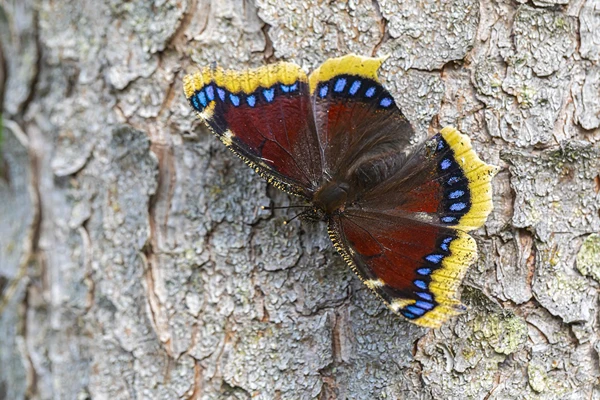
| Scientific Name | Nymphalis antiopa |
| Size | 0.8inches |
| Location | Throughout America |
| Identification | This butterfly has brown wings with yellow and blue borders. |
The mourning cloak butterfly is a huge, distinctive butterfly with unique characteristics that identify it from other butterflies. It has wingspan of up to four inches. Its wings are dark maroon or brown on the dorsal side, with ragged pale-yellow profits.
The black line separating the maroon and yellow is dotted with bright, iridescent blue dots. The ventral side of the wings covers Gray striations with pale-yellow borders.
They belong to the Nymphalidae family and are known as brush-footed butterflies because of their hairy front legs. Moreover, there is no noticeable sexual variation in the species.
10) Pea Blue butterfly
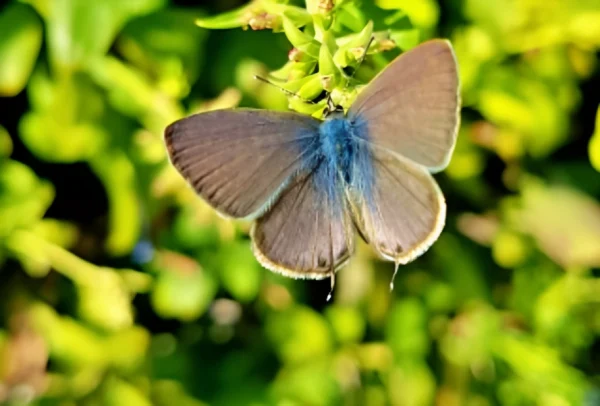
| Scientific Name | Lampides boeticus |
| Size | 24-32mm |
| Location | Europe, Africa ,and Australia |
| Identification | This butterfly has a bluish purple body with yellow outerlines. |
The pea blue, sometimes known as the long-tailed blue, is a tiny butterfly. The upperside is violet-blue with hair-like golden scales scattered across the whole surface of both wings.
Hindwing with a similar marginal line, a rather large round black subterminal spot in interspace 2, and a smaller spot in interspace 1, each ringed, sometimes with pale blue, sometimes with pale orange-ochreous.
This butterfly have an amazing contrast of blue and yellow colour, therefore, makes it a unique creature in the nature.
11) Callicore eunomia
| Scientific Name | Eunomia numberwing |
| Size | It has a wingspan of about 30-40 mm |
| Location | Found in the upper Amazonian regions |
| Identification | Adults have orangish-yellow wings with blue spots or markings. |
The Callicore eunomia’s forewings display a broad area of vibrant orange or yellow, creating a stark contrast against the black background.
On the hindwings, there is a striking blue area. This combination of colors makes them easily distinguishable.
This butterfly is adapted to the lush and diverse rainforests of this region.
Callicore eunomia was first described by renowned lepidopterist William Chapman Hewitson in 1853.
12) Yellow pansy
| Scientific Name | Junonia hierta |
| Size | Approximately 1-1.75 inches |
| Location | Tropical regions of Africa, Asia, and Oceania |
| Identification | Forewings are pale yellow with large blue spots |
The Yellow Pansy’s wings are bright yellow and the forewings feature a broad jet-black projection extending downward.
Female yellow pansy butterflies have a similar appearance to males but with slightly duller colors.
The female the blue spot on the anterior black area of the hindwing is smaller and less defined compared to males.
The larva of Junonia hierta has a dark brown or grey ground color with a broad dorsal stripe formed by tiny white and blue spots.
13) Bates’ asterope
| Scientific Name | Asterope batesii |
| Size | NULL |
| Location | Found primarily in inland Brazil |
| Identification | Butterfly with a dull brown background with vibrant blue on the inner corners and yellow in the middle |
Asterope batesii is primarily found in inland regions of Brazil. Its habitat encompasses areas such as Ayeyros, along the Tapajós River, and Tefé on the Upper Amazon.
The larvae of Asterope batesii have a specific dietary preference, feeding on plants belonging to the Paullinia species.
The background color of its wings is a dull brown hue, with vibrant blue on the inner corners, creating a visually captivating contrast against the brown backdrop, along with bright yellow markings in the middle.
14) Indian Fritillary
| Scientific Name | Argynnis Hyperbius |
| Size | Around 3.1-3.9 inches |
| Location | Australia and south and southeast Asia |
| Identification | Indian Fritillary has a rich orange-yellow forewing with vibrant blue edges. |
Indian Fritillary is primarily found in regions spanning from South and Southeast Asia to Australia.
The male Indian fritillary showcases a rich shade of orange-yellow, while the hindwing is a slightly paler yellow. The hindwing also contains a series of transverse markings and blue and ochraceous bands.
The upper side of the female’s wings features a black area on the apical half of the forewing, with a purple and white band.
The larva features a wide orange-tawny dorsal stripe running along its back.
15) Obi Island birdwing
| Scientific Name | Ornithoptera aesacus |
| Size | Around 5-7.4 inches |
| Location | It is a species endemic to the Island of Obira |
| Identification | The butterfly has turquoise-blue forewings with yellow markings and a vibrant yellow body. |
The Obi Island birdwing is a rare and distinctive species of birdwing butterfly.
While closely related to the more widespread Ornithoptera priamus, the male Obi Island birdwing stands out due to its captivating feature – a brilliant turquoise-blue sheen.
The International Union for Conservation of Nature (IUCN) has categorized this butterfly as ‘Vulnerable.’
Frequently Asked Questions:
1) What is the yellow butterfly with blue on the bottom?
The clouded Sulphur butterfly (Colias philodice) is a butterfly with yellow wings with a pale blue tint on the undersides.
2) What kind of butterfly has yellow wings and blue tips?
The common Tiger Swallowtail butterfly (Papilio glaucus) has yellow wings with vibrant blue edges.
3) What kind of butterfly is black yellow and blue?
The Tiger Swallowtail butterfly (Papilio glaucus) is a butterfly that boasts black, yellow, and blue color on its wings. It has bold yellow wings with black stripes and patches, along with blue-colored bands near the bottom half of the wings.
4) What is the rarest butterfly color?
Blue is the rarest color to occur in a butterfly.
5) Is Blue Butterfly good luck?
In many cultures, a blue butterfly is considered a symbol of good luck. It is believed that encountering a blue butterfly can bring positivity, happiness, and good fortune.
6) Is it lucky to see a blue butterfly?
Seeing a blue butterfly is often considered lucky and is believed to bring positive changes or a sense of joy and peace.
7) How rare is a blue butterfly?
Some species of blue butterflies are considered moderately rare, while sightings of others in certain regions may be more common.
8) What is the rarest butterfly to see?
Queen Alexandra’s Birdwing butterfly (Ornithoptera alexandrae) is the rarest butterfly to see. It is also important to know that the rarity of the butterfly depends on the geographic location.
9) What is a blue butterfly called?
The common blue butterfly (Polyommatus icarus) is a blue butterfly.
Conclusion
At last, these are some of the amazing yellow and blue butterflies found in nature. They are considered a sign of positivity and new beginnings. We hope you like our article.
Also Read:
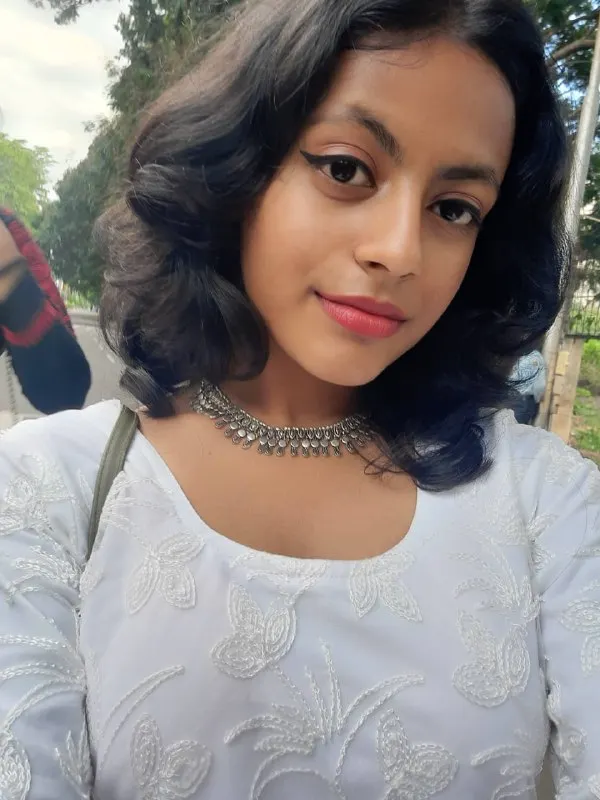
Hi everyone, my name is Shawna, and I’ve always been fascinated by the fascinating diversity of flora and fauna that our nature has in it. I am currently studying biotechnology and am particularly interested in animal biotechnology, delving into the intricate processes that define their true nature and uniqueness.
